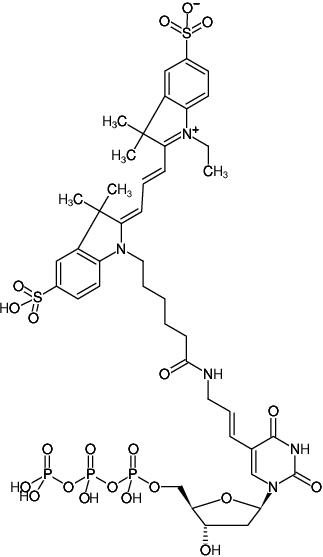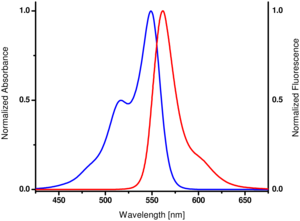Aminoallyl-dUTP-Cy3
5-(3-Aminoallyl)-2'-deoxyuridine-5'-triphosphate, labeled with Cy3, Triethylammonium salt
| Catálogo Nº | Apresentação | Preço (R$) | Comprar |
|---|---|---|---|
| NU-803-CY3-S | 10 μl (1 mM) | Sob demanda | Adicionar ao Carrinho |
| NU-803-CY3-L | 5 x 10 μl (1 mM) | Sob demanda | Adicionar ao Carrinho |


Excitation and Emission spectrum of Cy3
For general laboratory use.
Envio: shipped on gel packs
Condições de armazenamento: store at -20 °C
Short term exposure (up to 1 week cumulative) to ambient temperature possible.
Validade: 12 months after date of delivery
Fórmula molecular: C43H56N5O21P3S2 (free acid)
Peso molecular: 1135.97 g/mol (free acid)
Pureza: ≥ 95 % (HPLC)
Forma: filtered solution (30 kDa) in 10 mM Tris-HCl
Concentração: 1.0 mM - 1.1 mM
pH: 7.5 ±0.5
Propriedades espectroscópicas: λexc 550 nm, λem 570 nm, ε 150.0 L mmol-1 cm-1 (Tris-HCl pH 7.5), CF260 0.08
Formulários:
Incorporation into DNA/cDNA by
- Primer Extension with Klenow fragment[1]
- PCR with Taq polymerase in-house data
- Nick Translation with DNAse I/ DNA Polymerase I in-house data
Descrição:
Aminoallyl-dUTP-Cy3 is recommended for direct enzymatic labeling of DNA/cDNA e.g. by PCR and Nick Translation. It is incorporated as substitute for its natural counterpart dTTP. The resulting Dye-labeled DNA/cDNA probes are ideally suited for fluorescence hybridization applications such as FISH or microarray-based gene expression profiling. Optimal substrate properties and thus labeling efficiency is ensured by an optimized linker attached to the C5 position of uridine.
Recommended Aminoallyl-dUTP-Cy3/dTTP ratio for PCR and Nick Translation: 30-50% Aminoallyl-dUTP-Cy3/ 50% dTTP
Please note: Protect the Dye-labeled dUTP from exposure to light and carry out experimental procedures in low light conditions. The optimal final concentration of the Dye-labeled dUTP may very depending on the application and assay conditions. For optimal produdct yields and high incorporation rates an individual optimization of the Dye-labeled-dUTP/dTTP ratio is recommended.
Referências selecionadas:
[1] Walsh et al. (2017) Measurement of incorporation kinetics of non-fluorescent native nucleotides by DNA polymerases using fluorescence microscopy. Nucleic Acids Res. 45 (21):e175.
